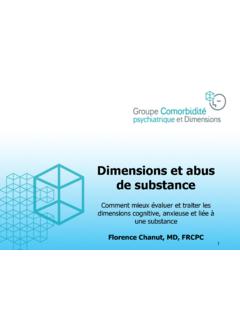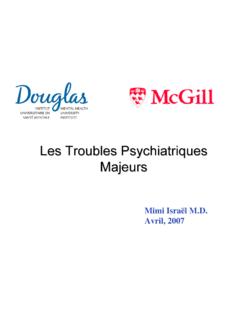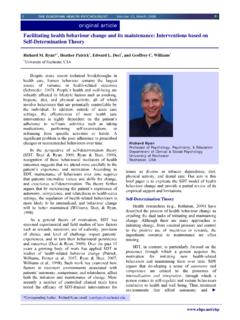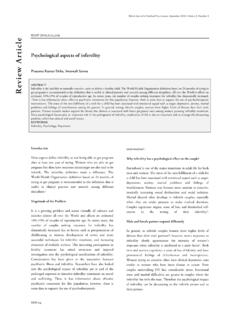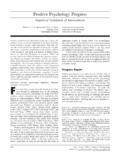Transcription of Transference Focused Psychotherapy* - Douglas
1 Transference Focused Psychotherapy* TFP Lina Normandin, Universit Laval 21 mars 2013 *Les diapositives sont la propri t du Personality Disorders Institute. Ne peuvent tre reproduites en tout ou en partie 1 PERSONALITY DISORDERS INSTITUTE Weill Medical College of Cornell University Otto F. Kernberg, , Director John F. Clarkin, , Co-Director Eve Caligor, MD Kevin Meehan, PhD Monica Carsky, PhD Mark Lenzenweger, PhD Jill Delaney, MSW Kenneth Levy, PhD Diana Diamond, PhD Mallay Occhiogrosso MD Eric Fertuck, PhD Barry Stern, PhD Kay Haran, PhD Michael Stone, MD Frank E. Yeomans, MD 2 TFP Manual Clarkin JF, Yeomans FE, & Kernberg OF (2006). Psychotherapy for Borderline Personality: Focusing on Object Relations. Washingon, DC: American Psychiatric Press. Yeomans FE, Clarkin JF, & Kernberg OF (2002). A Primer of Transference - Focused Psychotherapy for the Borderline Patient.
2 Northvale, NJ: Jason Aronson. Yeomans FE, Selzer MA, & Clarkin JF. (1992). Treating the Borderline Patient: A Contract-based Approach. New York: Basic Books 3 References (continued) Yeomans FE, Delaney JC, Renaud A. La psychoth rapie focalis e sur le transfert. Sant Mentale au Qu bec 2007; 32(1), 17-34. Diamond D, Yeomans FE. Le r le de la TFP dans le traitement des troubles narcissiques. Sant Mentale au Qu bec 2008 ; 33(1) : 115-139. Kernberg PF, Weiner AS, & Bardenstein KK (2000). Personality Disorder in Children and Adolescents. New York: Basic Books 4 References (continued) Clarkin, , Levy, , Lenzenweger, , & Kernberg, (2007). Evaluating three treatments for borderline personality disorder: a multiwave study. American Journal of Psychiatry, 164, 922-928. Levy, K. N.; Meehan, K. B.; Kelly, ; Reynoso, J. S.; Clarkin, J. F.; Lenzenweger, M. F.; & Kernberg, O.
3 F. (2006). Change in attachment and reflective function in the treatment of borderline personality disorder with Transference Focused psychotherapy. Journal of Consulting and Clinical Psychology 74:1027-1040. 5 Main research articles Clarkin, , Levy, , Lenzenweger, , & Kernberg, (2007). Evaluating three treatments for borderline personality disorder: a multiwave study. American Journal of Psychiatry, 164, 922-928. Levy, K. N.; Meehan, K. B.; Kelly, ; Reynoso, J. S., et al (2006). Change in attachment and reflective function in the treatment of borderline personality disorder with Transference Focused psychotherapy. J of Consulting and Clinical Psychology 74:1027-1040. Doering, S. et al (2010). TFP vs. treatment by community therapists for BPD: RCT. British Journal of Psychiatry , 196(5) 6 7 Transference Focused Psychotherapy (TFP) Psychodynamic psychotherapy Developed to treat severe personality disorders Empirical support for treatment of DSM-IV BPD Combines dynamic approach with structure, limit setting and attention to secondary gain 8 Distinction with traditional psychotherapy Importance of the frame Level of activity of the therapist Attention to non-verbal communication and countertransference Limitation of free association 9 Distinction with traditional psychotherapy (continued) Centration on the here and now ( Transference ) Notion of aggressivity and rage Interpretative process : clarification, confrontation and interpretation.
4 10 Structural Classification of Personality Disorders by Severity Normal personality Neurotic level of personality organization Borderline level of personality organization High level borderline Low level borderline Psychotic level of functioning 11 FIGURE 1 Relationship between familiar, prototypic, personality types and structural diagnosis. Severity ranges from mildest, at the top of the page, to extremely severe at the bottom. Arrows indicate range of severity. Kernberg & Caligor (2005). A psychoanalytic theory of personality disorders. In: Major Theories of Personality Disorders, 2nd Ed. Eds: Clarkin & Lenzenweger. NY, Guilford, 115-156. 12 Borderline Personality Organization: Clinical Correlates of Structural Features -I Identity pathology Sense of self and others is fragmented, distorted and superficial Difficulty reading and self Lack of continuity in time Feelings of emptiness 13 Borderline Personality Organization: Clinical Correlates of Structural Features - 2 Splitting- based /Lower level defenses Unstable, black and white experiences of the world (leads to chaotic interpersonal relations) Variable Reality Testing Distinguish internal and external reality Deficits in social reality testing Can experience gross distortion under stress with micro-psychotic phenomena 14 Borderline Personality Organization.
5 Clinical Correlates of Structural Features - 3 Pathology of Object relations Difficulty appreciating the needs of the other independent of the self, difficulty with healthy dependency, difficulty with intimacy Pathology of Moral Functioning Inconsistent or lacking values and ideals Unethical behavior 15 Why do we need TFP? It is more easy to change symptoms and behaviors as opposed to However, a change in personality structure make people more happy and productive Love & Work 16 Theory behind the TFP treatment A review of basic object relations theory and primitive defenses Identity diffusion is caused by splitted off parts of the patient experience of the world 17 Theoretical Underpinnings of TFP: Object Relations Theory Self Other Affects The Object Relations Dyad 18 Development of BPO Predominance of negative affect over positive leads to reliance on splitting, to protect the good from the bad.
6 Splitting interferes with integrative processes and advancement from paranoid-schizoid to depressive position Results in identity diffusion as opposed to identity confusion of normal adolescent. 19 Dyads as Building Blocks The individual identifies with the entire relationship, not just with the self-representation or the object representation The dyad exists within the individual and it s basic impact is on self relating to self, although it regularly gets played between self and others Dyads of similar affective charge aggregate 20 Split Organisation 21 Normal Organisation 22 23 TFP- What Changes? Evolution of Treatment From Splitting and fragmentation to integration From the projection of negative motivations to the capacity to take responsibility for one s thoughts, feelings, actions and integrate them In older psychoanalytic terminology, to move from the Paranoid-schizoid position to the Depressive position ---------------------------------------- - How does TFP facilitate this change?
7 24 Transference The activation of internal object relations in the relationship with the therapist. These internalized relations with significant others are not literal representations of past relations, but are modified by fantasies and defenses In borderline patients, internal object relations have been segregated and split off from one another Include fantasied paranoid and idealized object relations ( all good and all bad ) Working with object relations that are activated in the immediate moment creates a therapy that is experience-near 25 Working with Transference An affect is the manifestation of an underlying object relation Since Transference is the activation of internal object relations, leads to the activation of affects and conflicts Basic strategy: to tease out these internal relationships, to help the patient Gain and tolerate awareness of these internal relationship representations, Integrate them into a coherent whole 26 Patient s Internal World S = Self-Representation O = Object - Representation a = Affect Examples S1 = Meek, abused figure O1 = Harsh authority figure a 1 = Fear S2 = Childish-dependent figure O2 = Ideal, giving figure a2 = Love S3 = Powerful, controlling figure O3 = Weak, Slave-like figure a3 = Wrath.
8 -S3 -O3 -S1 -O1 +S2 +O2 -a3 -a1 +a2 Etc. 27 Why focus on Transference ? (ref: Donegan) Experience of Self ..and of therapist S1 S2 S3 O1 O2 S1 S2 S3 O3 a1 a2 a3 28 Victim Persecutor Persecutor Victim (Oscillation is usually in behavior, not in consciousness) OBJECT RELATIONSHIP INTERACTIONS: OSCILLATION Fear, Suspicion, Hate Fear, Suspicion, Hate Self-Rep Object Rep 29 Victim Cared-for Child Persecutor Perfect Provider Opposites OBJECT RELATIONSHIP INTERACTIONS: DEFENSE Fear, Suspicion, Hate Longing, Love 30 COMMUNICATION CHANELS Verbal Non-verbal Countertransference 31 BEGINNING TREATMENT History Sessions Discussion of Dx and Contrac=ng Sessions Family Session Therapy Pre- Therapy Therapy Begins (or not) : OKen a Sense of Urgency Goal: To move from Ac=ng Out to Transference 32 Structural Assessment 33 Clinical Assessment = Structural Assessment Assess.
9 Identity Object relations Defenses, coping, defense rigidity Value system and ethics Reality testing 34 35 Structural Interview Kernberg, Severe Personality Disorders (1984) Definition: Method of clinical assessment that focuses on the patient s present and past symptomatology, the patient pesonality organization. The quality of the here and now interactions between the patient and the therapist and highlights the patient family and personal history. It is a tactful assessment of the main defenses, identity, cognitive or affective conflicts, social reality testing. Maintain enough tension so that the predominant conflict will emerge.. 36 Structural Interview Three main questions: Why are you here? What is the nature of your difficulties and how do you understand it? What are you expecting from the treatment? How are you now ? (optional) Detailed description of Self and Other.
10 37 Few notices Channels of communication Therapist neutrality It raise anxiety Empathy 38 Splitting All Good is not necessary Good. Agressivity is not necessary bad. Usefulness of negative Transference . 39 Structural Interview as a microcosme of TFP Progress from Clarification, to Confrontation, to Trial interpretation 40 STIPO : Structured Interview of Personality Organization Mesure la structure et les dimensions de la personnalit Structure : Normal N vrotique Limite Psychotique Dimensions: Consolidation de l identit , Qualit des relations d objets Usage de d fenses primitives ou volu es Nature du contact avec la r alit et sympt mes dissociatifs Qualit de l agression Int gration du Surmoi 41 Identit Identit int gr e Exp riences de Soi et de l Autre int gr es, subtiles et avec profondeur Objets entiers Stables Identit fragment e Exp riences de Soi et de l Autre polaris es, contradictoires et superficielles Objets partiels Hautement instables R f re la fois l organisation (int gr e ou non) et au contenu du monde interne du patient (Soi et Autre)


